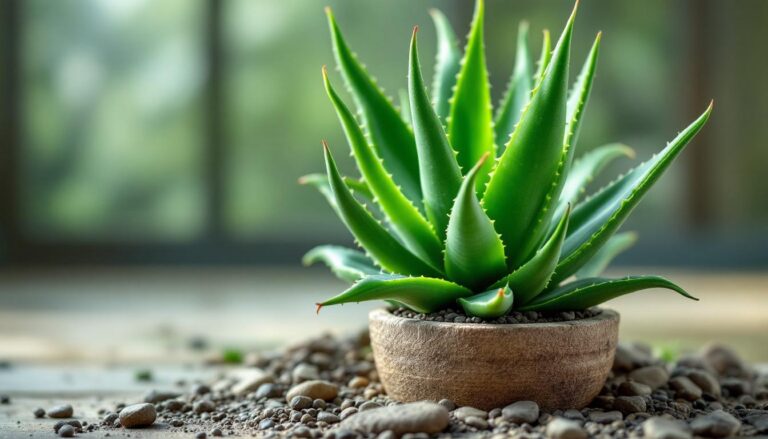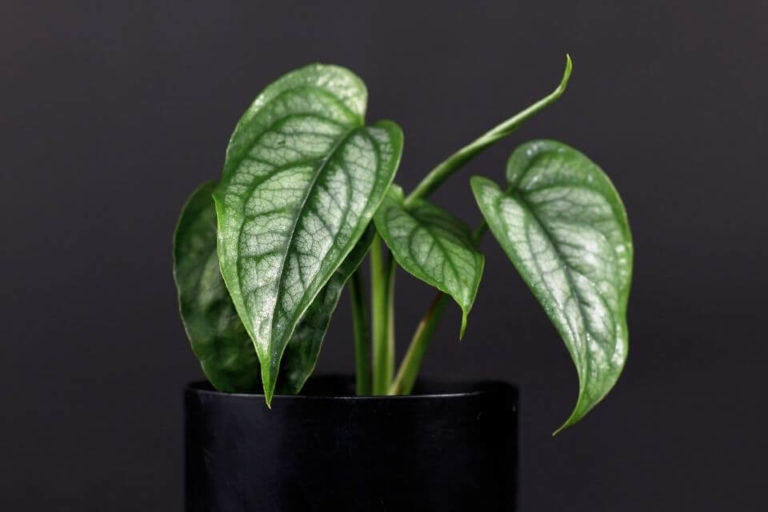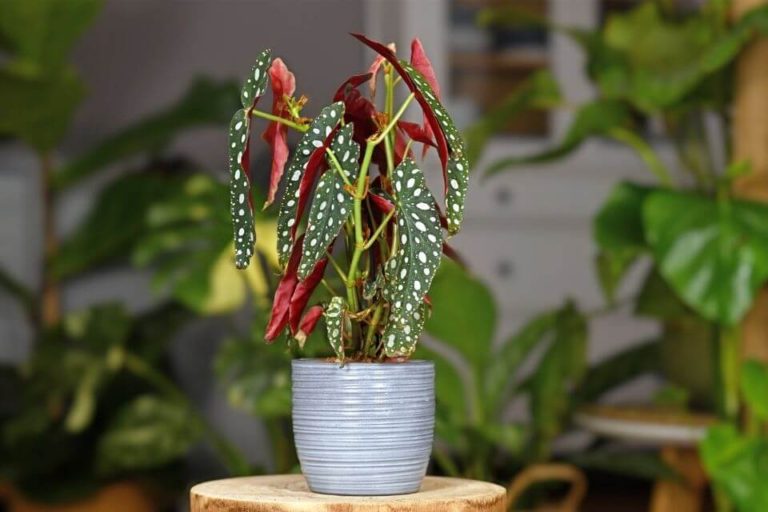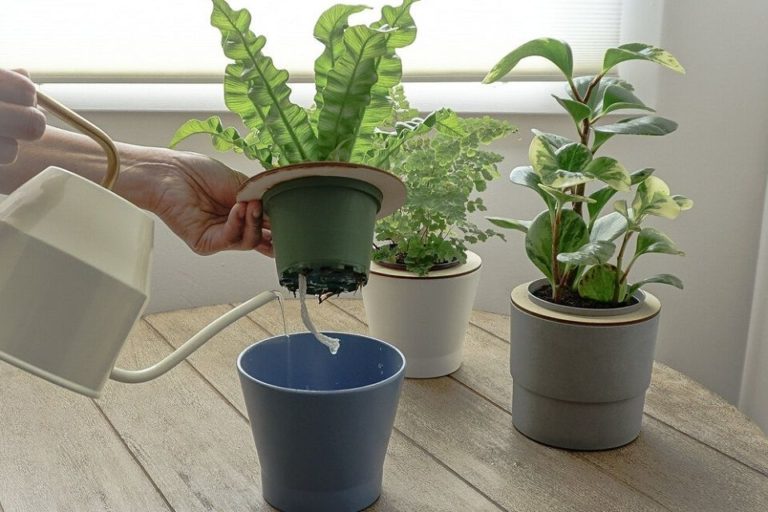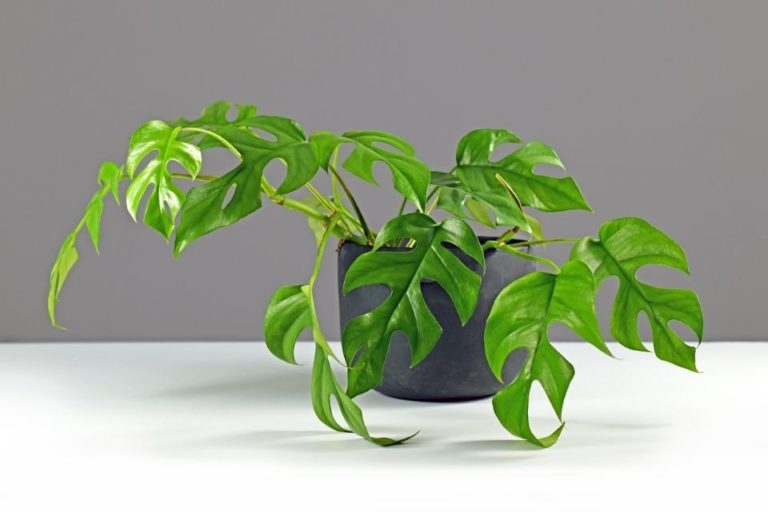Peacock Plant Care 101 – Caring, Planting, Maintenance And Propagation
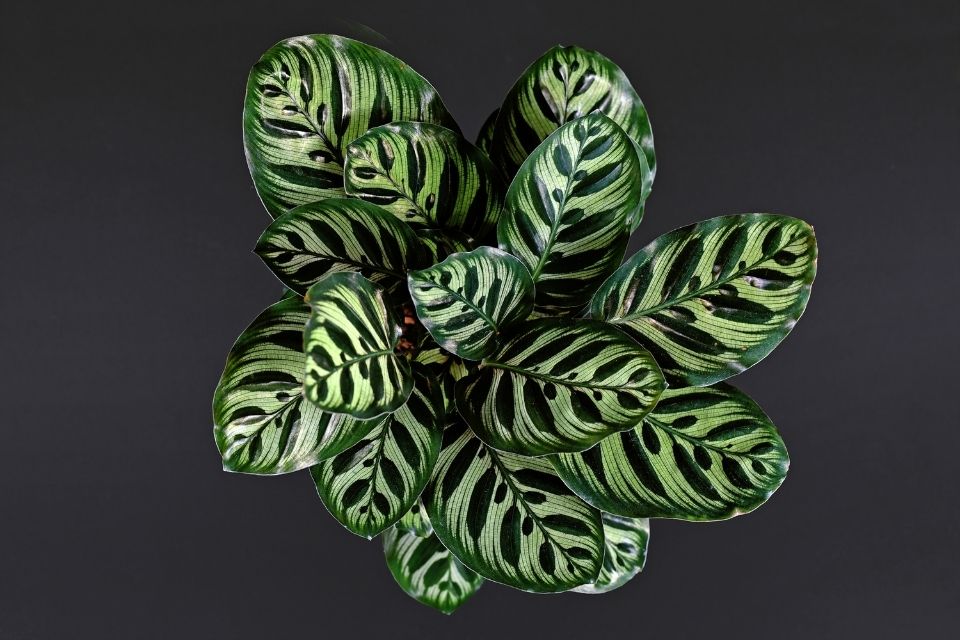
The Peacock Plant is commonly known because of its striking foliage and is at times referred to as ‘Prayer Plants‘ since they often raise their leaves up and curl them shut overnight.
The Peacock Plant is scientifically referred to as “Calathea Makoyana” or “Goeppertia Makoyana”.
This Calathea plant lies under the genus of “Goeppertia” and is mostly used as a house plant because of its beautiful Peacock feather-looking appearance.
The plant originates from the tropics and it has a tall and slender appearance which requires good care to look attractive in your house.
In this Calathea Makoyana care guide, you will learn about care, planting, propagation, watering, lighting requirement, and more information for good care of the Peacock Plant.
| Highlights: | |
|---|---|
| Common Names: | Peacock Plant, Cathedral Windows |
| Botanical Name: | Calathea Makoyana, Calathea makoyana |
| Plant Family: | Marantaceae |
| Plant Type: | Tropical perennial |
| Origin/Native: | Brazil |
| Care Level: | Easy |
| Grow Zone: | 10A - 11 (USDA Hardiness Zone) |
| Size: | Up to 2 feet tall |
| Soil Requirement: | Light and well-draining soil with low pH levels |
| Water Requirement: | Medium moisture levels |
| Sun/Lighting: | No direct sunlight, but require bright light |
| Temperature Req: | 60 - 75°F (16 - 24°C) |
| Propagation: | Stem segments of tip cutting |
| Toxicity: | Non-toxic |
| Flowering/Color: | White |
| Uses: | House plant for decorative purposes |
TABLE OF CONTENTS
Peacock Plant Overview and Origination
You cannot find any other plant like Calathea Makoyana that has beautiful patterns like peacock feathers. That is why it has the name Peacock Plant, and it also has another alternative name is called Cathedral Windows.
The Peacock plant is an evergreen perennial plant that comes from the Marantaceae plant family and originates from Brazil. It is a popular household plant as people love it because of its beautiful foliage and bold markings.
Peacock Plant Size, Growth and Appearance
The Peacock Plant takes all the appearance and beauty of a Peacock’s tail, and that is why it was given the glorious name of the bird. Calathea Makoyana has green shaded leaves that are about 10 inches long.
The leaves of this Peacock Plant are filled with thin dark-colored lines and ovals-shaped patterns filled with dark green shades that make it a feather likes appearance.
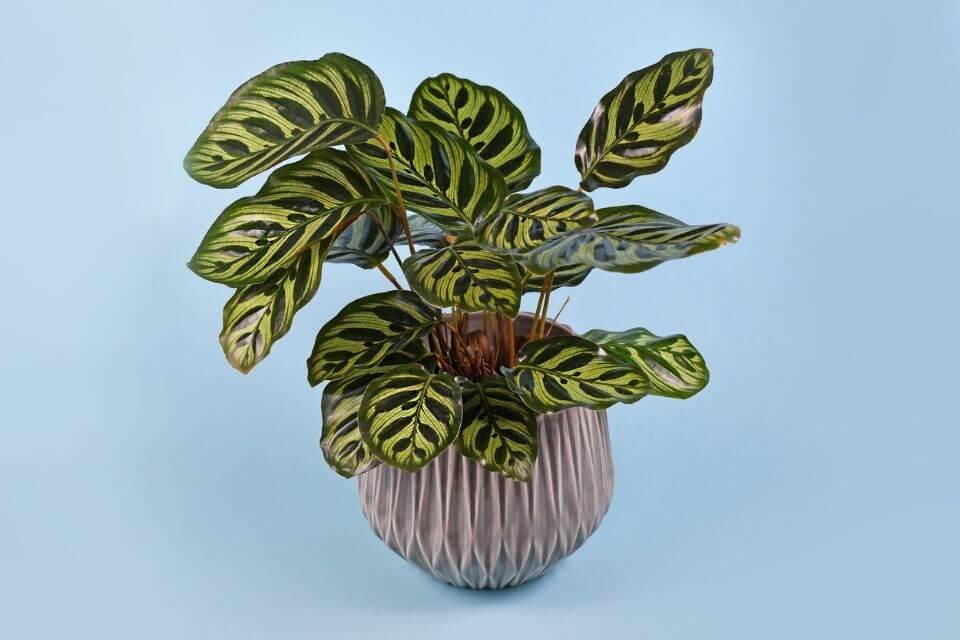
The other side of the leaves has the same patterns, but the color shades are different. It has pink to purple shades. New leaves roll up to display their pinkish-red undersides portraying another splash of color.
As a house plant, it grows up to 2 feet tall and around 2 feet wide with leaves of 4 to 8 inches long. Leaves assume a spiral pattern along the stem when growing.
The topside of the leaves varies in patterns and colors but the underside is purple. The top side may come in different colors such as white, green, silver, or pink.
A peacock plant grows intensively between March to October and slows down its growth during winter.
Keeping the soil moist without making the roots wet helps the plant to thrive and grow well. It is also essential to ensure the plant is well humid to facilitate growth.
When the leaves are growing, they display their underside since they are rolled up and blending with the already grown green patterned leaves; they display a spectacular appearance.
Peacock plant leaves rise during the day and lowers at night which is a characteristic of the “Marantaceae” family to which the Calathea Makoyana plant belongs.
Peacock Plant Care
The Peacock Plant requires specific care requirements for it to be fully grown and maintain its natural form and appearance. This factor makes the plant more challenging to nurture, especially if you are new to houseplants.
Various essentials such as bright filtered light, humidity, adequate moisture, consistent warmth are some of the important requirements it a must for a healthy plant.
Balanced fertilizer with higher levels of nitrogen is also essential to maintain its consistent growth.
– Soil Requirement
For any type of plant, the soil is a key element to consider when planting to expect excellent results. Peacock Plant grows well in soil that has a high level of moisture reticence and is well-drained.
Mixing two types of soil with those characterized as peat, sand and perlite usually work best in this case. For vibrant leaf production and color, the Calathea Makoyana plant also needs soil that is high in organic matter and more humus.
Using African Violet Potting Mix, or other available peat mixes in the market is the best base for making soil. In addition to this, you must add a third of coarse matter including Coconut coir, sand, or pine bark.
You can replace a portion of peat moss with compost. Because Compost contributes more nutrients to the soil that you will not have to fertilize the Peacock Plant until you do the next potting cycle.
Compost is a good water retainer same as peat; therefore, you should add compost to the soil mix. Please keep in mind not to mix too much compost otherwise the soil becomes soggy.
– Watering Calathea Makoyana
The Peacock Plant calls for a good balance when it comes to keeping the soil moist. You must follow simple rules for its watering to keep it healthy and thriving.
Under-watering Calathea Makoyana can lead to curling up of leaves while too much water can cause rotting of the roots.
Peacock Plants require consistent and even levels of moisture. So is always good for you to use a moisture meter to help them in deciding whether the plant needs watering.
You can also use the technique of touching the soil with your fingers after every few days and add water if the top inch of the soil is dry. You need to give the plant a break mostly during winter but it should be reduced considerably.
Not all types of water are preferred for watering the plant. The most recommended is distilled water, or some harvested from rainfall and not tap running water.
Calathea Makoyana plants are very sensitive to most of the minerals found in the water, such as fluoride, and can affect the leaves, making them turn brown. The water should not be extremely cold to avoid shock on the plant.
– Lighting
Having originated from the tropics of Brazil, the Peacock plant is not used to direct sunlight but is used to the shades from large trees in the Brazilian tropical forest.
To satisfy your plant’s needs you must plan a schedule for some filtered light in your house. You just must position your plants where they can get access to indirect or filtered sunlight.
Mostly near the windows is the best position to put your plants. Direct sunlight affects the leaves and little or no sunlight will slow down the plant growth. Finding a balance works lighting magically words.
If your Calathea Makoyana Plant is in a room with more light, you can decide to put it away from the widows or behind other plants that have a high tolerance to sunlight.
You know that your plant is getting more sunlight, the eye-catching pattern fades away and starts turning brown and when it is not getting enough light, the leaves grow smaller and the patterns become less vivid.
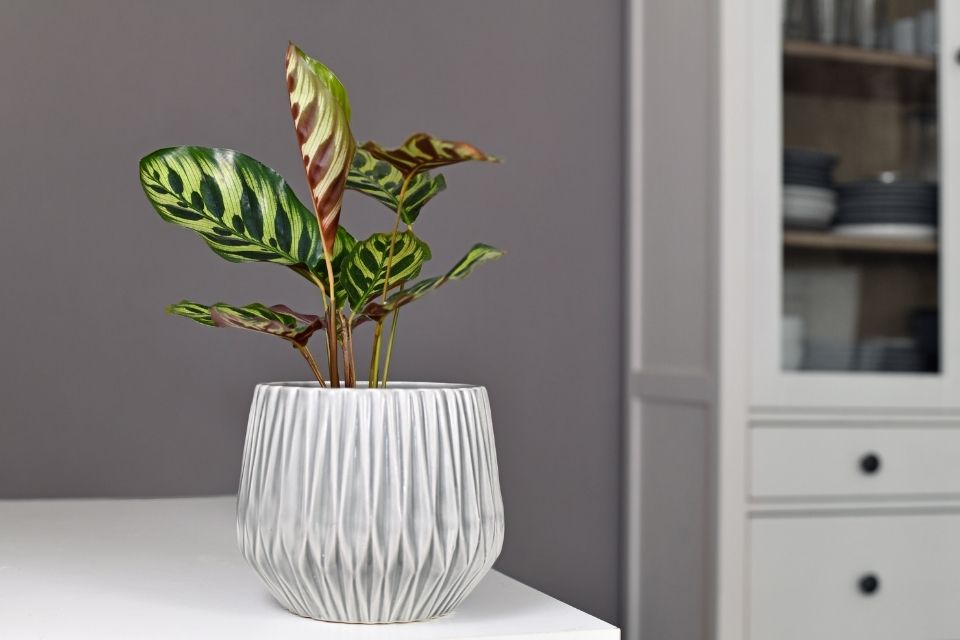
– Temperature Recommendations
For your peacock plant to thrive, you must maintain ideal temperatures which are between 60 ºF to 75 ºF (16 to 24°C). The temperatures should also not fall below 61 °F (16 °C).
You should also ensure that you do not expose your plants to any extreme changes such as cold drafts and quick shifts in temperatures.
– Humidity
It is important to create an environment with high levels of humidity to help your plant thrive. You need to give your plants a humidity of about 60% or higher to ensure continuous health.
Low humidity results in your peacock plant turning brown on the leaves or even exhibiting curly leaves.
You can therefore group your plants that require more humidity and invest in a humidifier that assists you in keeping your plants humid all the time.
– Fertilizer
During the growth period of your peacock plant, you must fertilize it after every two weeks. You can use different fertilizers such as chemical and organic fertilizers to make your peacock plant have a balanced nutrient combination to enhance healthy growth.
Chemical Fertilizer
To avoid brown spots on the leaves, the Calathea Makoyana plant requires high nitrogen reach fertilizers. A balance of NPK 3-1-2 fertilizer is more commendable for the plants.
Using too much Phosphorus would also affect the plants by causing brown spots on the leaves. The Peacock plant is sensitive to excess fertilizer, so it is advisable to dilute it to minimize its strength.
Because of the presence of salt in the soil caused by consistent fertilizing using chemical fertilizer, it is recommended to leach the soil after a duration of one to two months.
You should make sure you water your plant every time before applying fertilizer to avoid burning the roots. Also, during winter, the plant grows at a slow rate therefore you are not supposed to fertilize it at all.
Organic Fertilizer
There are many liquid fertilizers available for use if you prefer using organic fertilizer on your plants.
You can also prefer to make your organic fertilizer by mixing compost into the soil at the time you do your re-potting and ensure your plants receive the nutrients they require.
This can be repeated every time you are re-potting. The disadvantage with using compost is that you will not be able to control the number of nutrients you add to your plants.
Compost is also a water-retaining component and hence using it in high quantities can make the soil soggy which may affect the roots.
You can make good compost by preparing it in advance and leaving it for a few days to cook then use the mixture since it’s more balanced to fertilize your plants.
Pruning Peacock Plant
The Peacock plant does not require much pruning since its leaves grow systematically and it is not too bushy. You just need to cut off the damaged leaves and leave the healthy ones to continue growing.
Peacock Plant Re-Potting
As your Peacock Plant grows bigger, roots also become more hence may squeeze the pot. At this point, therefore, recommended changing the pot after some time, which is referred to as re-potting.
It is good to re-pot after every two years and uses a larger pot compared to the previous. It is also good to report during spring and fall. Fill the new pot with fresh soil and remove all the damaged roots for your plant to look as if it has been newly planted.
Provide extra humidity to your plant and provide less light for a few days for your plant to recover from re-potting and pick again to continue growing.
Propagation of Peacock Plant
When your peacock plant grows big enough, you ought to propagate it through division. It is normally done through root division.
During re-potting, this is the best time to propagate your plant. At the period of re-potting during spring, the plant is growing again and if it is propagated at this point, it will grow magnificently.
To have a successful propagation, remove the plant from the pot and clean the dirt from the roots. Look at where the roots attach to their separate stem and leaves and propagate them then plant each new plant on its own.
Make sure you keep them on the required nutrients and temperatures to facilitate their recovery from propagation trauma.
Peacock Plant Uses
The peacock Plant has a variety of uses, some being health benefits. For it is a house plant, it helps in purifying the air.
Since plants take in carbon dioxide and release oxygen, they make the house well-aerated hence creating a more relieving and relaxing ambiance.
The plant also helps in removing toxic substances from the air, which may be because of cleaning products.
The beautiful leaves of the plant are eye-catching and create attention and attraction in the house hence it is preferred for decorative purposes in houses and offices.
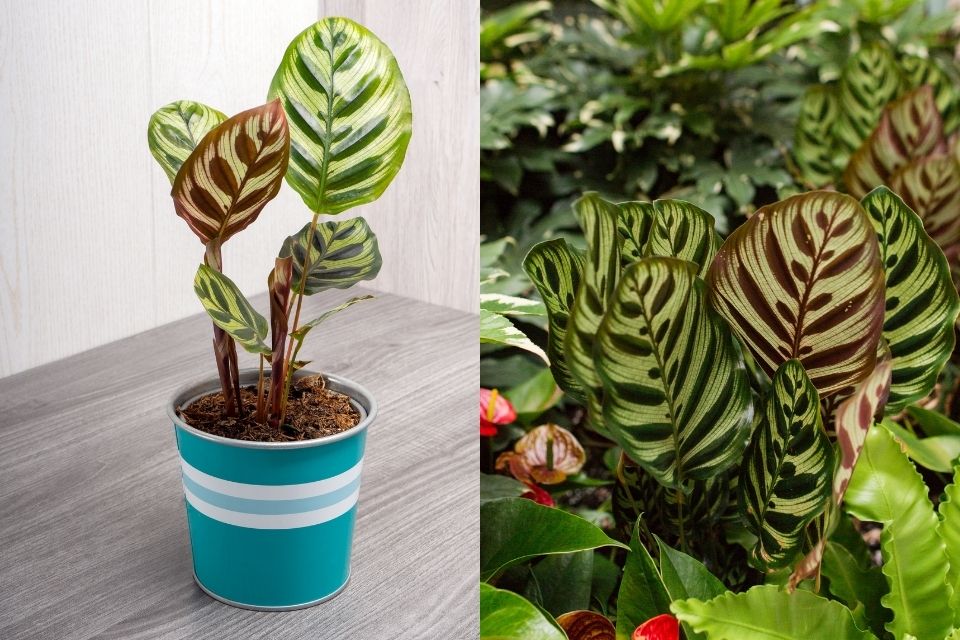
Peacock Plant Common Diseases
Calathea Makoyana plant is resistant to common problems and is not known for having any major disease problems. However, some insects may attack the plant if it is deprived of its normal growing conditions.
It is therefore advisable to always maintain all conditions necessary for its growth present to prevent these problems from arising. When the plant has low humidity, it has a high chance of being affected by spider mites.
– Pseudomonas Leaf Spot
This is a problem that the Peacock Plant encounters after bacteria called Pseudomonas infest it. The bacteria cause the leaves of the plant to have reddish-brown spots.
Infected plants may transmit the bacteria to other plants during watering. Cutting off the damaged leaves and using the copper-based antibacterial application is one way of treating your plant.
Ensure that you always keep your plants healthy by spraying them using pesticides to keep away any bacteria or diseases that may affect them.
– Root Rot
When the pot has poor drainage or the plant is over-watered, this water settles on the base of the pot, hence causing the roots to rot. Root rot is difficult to cure hence should be avoided as possible.
Ensure that you water your peacock plant when the topsoil is dry and the watering should be regulated. When you overwater your plant, oxygen cannot reach the roots hence making them not grow properly.
Plenty of water also causes fungi to infest the roots hence affecting the whole plant. Since nutrients from the soil pass through the roots to the leaves when the roots rot, they cannot perform their function.
Therefore no nutrients are circulating in the plant causing the leaves to turn yellow and eventually drop. You cannot identify root rotting with ease as it is below the soil and only comes out when it is too late.
You can only save your plant by cutting all the rotten roots and re-pot it hoping that the few remaining healthy roots will recover and help the plant grow back to be healthy and attractive.
Insect Pests Problems
There are common pests that can affect your Peacock Plants, causing damage to the plant leaves, stem, or roots, and may even cause death to the plant. Some pesticides are Aphids, Scale insects, and Spider mites.
These insects can be prevented from affecting the plants and even those plants that are already infested can be treated through various methods and the use of pesticides.
– Spider Mites
These are small insects that make small holes in the leaves of the Peacock Plant and turn the leaves to a brown color. Failure to prevent their spread will cause more infestation hence destroying the plants.
Inspect the plant regularly to identify any signs of a spider web or any sticky residue. There are various ways you can deal with the spider mites;
- Ensure you spray or shower your Peacock Plant using water to dislodge all the spider mites that may be present on the leaves.
- Use alcohol-soaked cotton to wash the leaves of the plant and ensure no spider mite is present or left attached to the leaves
- Use some dish-washing detergent mixed with water and spray on your plant. This makes sure that the plant is clean and safe from insects.
- Use insecticides such as Neem Oil to spray the plant to prevent other insects from infesting the plant and killing those that may be present.
- Insects such as ladybirds act as preventive insects and feed on those harmful insects that may feed on your plant. Hence introducing them would be a good move to ensure they eliminate those harmful spider mites affecting the plants.
– Aphids
Aphids appear to be the most common insects affecting household plants. They attach themselves to the plant leaves suck sap from peacock plants. Aphids affect the plant leaves, causing holes in the leaves.
They can be prevented by spraying the plants. They can also be removed using your hand and scraping them off. Isolate the affected plants to avoid them infecting other plants.
– Scale Insects
This poses a threat to different types of tree fruits and houseplants. Scale insect sucks sap from the Calathea Makoyana plants through piercing using their mouth.
They cause leaves to wilt or turn yellow and they may lead to the death of the plant in case they infest in large numbers. The scale insects can be eliminated through spraying with horticultural oil spray.
The oil clogs the breathing pores of the insects leading to their death.
Frequently Asked Questions
How Do You Know If Calathea Is Over Watered?
Peacock Plant requires moderate watering since you should not over-water or underwater. When you add more water than the required limits, the plant leaves start turning yellow and droop.
The problem begins from the roots where they rot and if not discovered can cause the death of the plant.
Why My Peacock Plant Leaves Curling?
When you notice your peacock plant leaves are curling, that is a sign that the plant lacks water. Check the soil for dryness and ensure that you water your plant properly to avoid curling leaves.
Does Calathea Need Sunlight?
During its lifetime, the Peacock Plant does not require direct sunlight. For it to grow normally and at the right pace, the peacock plant requires filtered light and not direct sunlight.
Although they originate from the tropical forests, it grows in the shades of other tall trees hence it is not used to direct sunlight.
Is Peacock Plant Toxic?
The Peacock plant has been classified as friendly and is nontoxic to humans and pets. There are no effects or side effects if you consume the foliage from the plant.
Does A Peacock Plant Flower?
Peacock Plants flower but not frequently. You may identify tiny white flowers from time to time peeping on mature Calathea Makoyana plants throughout the year though they are very insignificant.
Takeaway
The Peacock Plant is commonly referred to as Calathea Makoyana. It is a houseplant that has more strict environmental requirements for it to grow and exhibit its eye-catching appearance.
It requires to be planted on a pot that is well-drained to avoid rotting roots and soggy soil. You must inspect the soil regularly using your hands to check if the soil is dry so that you can water the plant again.
The plant also requires to be always kept humid and away from direct sunlight to facilitate its growth. The peacock plant required humidity of over 60% to aid it to thrive.
Make sure you re-pot your plant after a period since the plant continues to grow. Re-potting helps to change the plant to a larger pot to give it space for the roots to grow. Fertilizing and pruning your plant is essential for a healthy plant.
Also, ensure to spray the Peacock Plant with pesticides to keep away harmful insects from infesting your plants. Applying extra care and love to a Peacock Plant can help grow a beautiful and happy plant, even with all the strict requirements in place.
</p>

